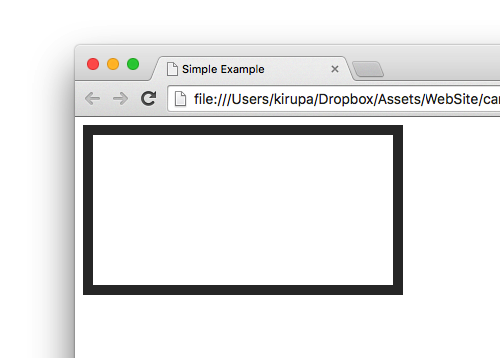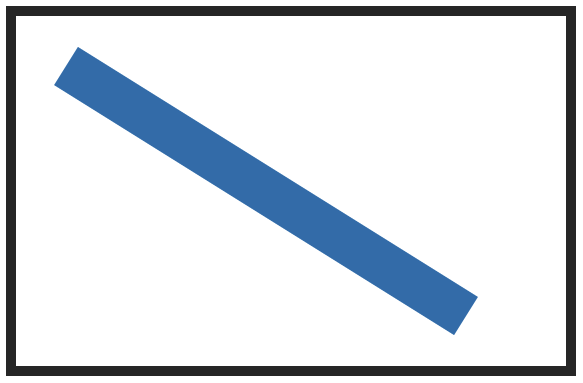Table of Contents
In the previous article, we got a high-level overview of the mysterious canvas by comparing it to the more-familiar DOM. That article was missing something crucial, though. It was missing the part where you get your hands wet writing markup and code. We are going to fix that up in this article.
We are going to put some of that conceptual knowledge you gained to good use by creating a simple example using the canvas element. I know that sounds a little scary, but you'll have a lot of help along the way. As you will find out soon enough, getting bizarre lines of JavaScript to draw something on the screen is a whole lot of fun.
Onwards!
The first thing we are going to do is add a canvas element to our page and make some adjustments to make them easier to work with. Before we get to any of that, you need is a blank HTML page that we will be working on. If you don't have a blank HTML page and need some help creating one, go ahead and create a new document and add the following lines of markup into it:
<!DOCTYPE html>
<html>
<head>
<title>Simple Example</title>
</head>
<body>
</body>
</html>
Once you have a blank HTML document setup, it's time for the main event you have been eagerly waiting the past 30-ish seconds for!
The canvas element is represented by the appropriately named canvas HTML tag, and it behaves just like any other HTML element you might have used in the past. To add a canvas element to your page, simply add the following opening and closing tag:
<canvas></canvas>
With this line, you have successfully added a canvas element to your document!
All that said, let's not celebrate too soon. If you preview your page right now, you'll be greeted with a deafening blank screen. The reason is that your canvas element by itself has nothing interesting going for it. It is merely a screen that JavaScript will eventually project pixels onto.
Working with something invisible isn't fun. To help us visualize our canvas element, let's specify some CSS to give it a border. Add the highlighted style block to your document inside your head block:
<!DOCTYPE html>
<html>
<head>
<title>Simple Example</title>
<style>
canvas {
border: #333 10px solid;
}
</style>
</head>
.
.
.
</html>
Once you've added that CSS, preview your page now. If everything worked out properly, our page will look as follows:

As expected, our CSS gave our canvas a 10 pixel wide dark gray border! While this is normally nothing to write home about, in our case, we can at least see some evidence that the canvas element is indeed alive...and possibly well. Now that we can see our canvas element, doesn't it look a little too small? Let's fix that next!
By default, your canvas elements are 300 pixels wide and 150 pixels tall. That might be a good size, but we want something bigger...like 550 pixels by 350 pixels. Our initial reaction might be to add some width and height properties to our existing style rule that targets our canvas. As it turns out, you can't really do that and get the intended result.
To properly change your canvas element's dimensions, add the width and height attributes to your canvas element's HTML directly:
<canvas width="550px" height="350px"></canvas>
Yes, I know that looks a bit odd given that we have been told to use CSS for setting the size of elements in HTML. I am not saying that you can't use CSS for setting the size. You can use CSS for setting the size on one condition: you preserve your canvas element's aspect ratio. If you aren't like we are, then setting the size via HTML is the only way to get the proper size without having all the pixels inside our canvas look all stretched and weird.
As you will keep finding out, there are some quirks about working with the canvas element that we all have to tolerate above and beyond the usual silliness commonly found in HTML elements :P
The last and probably most important step is to give our canvas element an ID value so that you can reference it via JavaScript. On the canvas element, add the id attribute and give it a value of myCanvas:
<canvas id="myCanvas" width="550px" height="350px"></canvas>
The full markup for everything you should have in your document so far should look something similar to the following:
<!DOCTYPE html>
<html>
<head>
<title>Simple Example</title>
<style>
canvas {
border: #333 10px solid;
}
</style>
</head>
<body>
<canvas id="myCanvas" width="500" height="500"></canvas>
</body>
</html>
At this point, I would say don't preview what you have in your browser. The reason is that you still won't see anything different or drastic from what you had earlier. That is about to change, though!
In the previous section, we basically defined our canvas element in markup. While important, what we've just done is a very VERY minor part of working with the canvas overall. The real work is about to happen in this section when we write the JavaScript that interacts with the canvas element to get pixels to show up on the screen.
Before we can write JavaScript, we need a script tag that will house the JavaScript we write. You can use an external JavaScript file or keep all of the code in the same document. For simplicity, I'll be keeping all of our code in the same document, and that will look something as follows:
<!DOCTYPE html>
<html>
<head>
<title>Simple Example</title>
<style>
canvas {
border: #333 10px solid;
}
</style>
</head>
<body>
<canvas id="myCanvas" width="550px" height="350px"></canvas>
<script>
</script>
</body>
</html>
With this minor addition, you are now set to write some JavaScript that will interact with our canvas element!
When it comes to working with the canvas, the first line of JavaScript you will almost always write will involve getting a reference to the canvas element in your HTML. This will allow you to start doing all sorts of canvas-ey things using JavaScript.
Now to get the reference, inside your script tag, go ahead and add the following line:
var canvas = document.querySelector("#myCanvas");
All we are doing here is initializing our canvas variable to our myCanvas element we defined in HTML earlier. We get a reference to the myCanvas element by relying on the querySelector function. This function is the cooler way of finding elements in HTML compared to the older getElementById and getElementsByClass functions you might be familiar with.
Here is some useful trivia. Our canvas element has two modes of operation. One mode is designed for drawing things in 2D, and this is the mode we care about for now. The other mode is all about supporting drawing in 3D. These modes are more formally known as rendering contexts. To be able to draw to our canvas element, we need to first specify the rendering context we want to use. That is done by calling the getContext method on our canvas object and passing in the argument for the 2D rendering context we want:
var canvas = document.querySelector("#myCanvas");
var context = canvas.getContext("2d");
The context variable now stores a reference to our canvas element's 2d rendering context and all the sweet drawing-related properties and functions that go along with it. To put all of this more simply, with a hook into the rendering context, you now have a pipeline through which you can issue commands to get pixels to show up inside your canvas!
All that remains at this point is to use the various tools JavaScript provides to get things drawn on the screen. We've covered a lot of ground here already, so I won't overwhelm you with what all the various draw commands are and how to use them. Instead, I am going to first provide some code for you to copy/paste/write to see our canvas element in action.
Go ahead and add the following lines to your code:
// draw a diagonal line context.moveTo(50, 50); context.lineTo(450, 300); // close the path context.closePath(); // specify what our line looks like context.lineWidth = 45; context.strokeStyle = "steelblue"; // get the line drawn to the canvas context.stroke();
Once you have done this, preview your HTML page in your browser. If everything went well, this time you will actually see something drawn with a thick blue diagonal line showing up:

All of the code you just pasted is responsible for getting this line to show up. Take a few moments to look at what each line of code does. Don't worry if it doesn't fully make sense. For this introduction, just notice that we are doing what looks like moving a virtual pen around and specifying the starting and ending co-ordinates:
// draw a diagonal line context.moveTo(50, 50); context.lineTo(450, 300);
There is even some code that seems to specify the thickness and color of the line that gets drawn:
// specify what our line looks like context.lineWidth = 45; context.strokeStyle = "steelblue";
In future articles, we will dive much deeper into what each of these commands do and learn precisely how they work. We will also look at the supporting code that is very important...despite me ignoring them in this lightning-fast overview haha. For now, just be proud of the massive amount of progress you made!
In this tutorial, we created a basic template that all future canvas-related content will follow. You have your canvas element in the HTML with some optional CSS and inline HTML attributes to help style it. You then have your JavaScript where you reference the canvas element, gain access to its rendering context, and then issue the draw commands needed to get pixels to appear.
Just a final word before we wrap up. If you have a question and/or want to be part of a friendly, collaborative community of over 220k other developers like yourself, post on the forums for a quick response!
